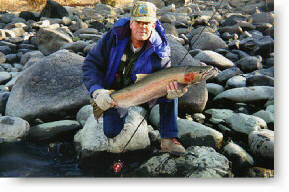
Thompson
River, BC
The
beautiful Thompson River, one of British Columbia's most important
rivers, is home to many species of game
fish. One of the Fraser River's major tributaries,
the Thompson provides the highway for millions of spawning Sockeye,
Chinook, Coho and Pink salmon. Year-round residents include
sturgeon, Rainbow trout, Dolly Varden and Mountain Whitefish.
It is also the freshwater home to some of the largest and strongest
Steelhead found in North America.
Named
by Simon Fraser after the Northwest Trading Company's explorer/topographer
David Thompson, this river is huge with a drainage area of more
than fifty thousand square kilometers (more than 20,000 miles).
The
Thompson River is formed at the city of Kamloops, by the joining
of the North and South Thompson Rivers. This High Country region
of B.C. (see regional
map) is rich in history as well as recreational
opportunities. Be sure to explore all the points
of interest during your travels.
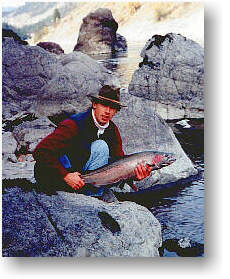 Flowing
from the Rocky Mountains, the North Thompson passes by the communities
of Blue Water, Avola, Vavenby, Clearwater, Little Fort, Barriere
and Heffley Creek before meeting the South Thompson at Kamloops.
Flowing
from the Rocky Mountains, the North Thompson passes by the communities
of Blue Water, Avola, Vavenby, Clearwater, Little Fort, Barriere
and Heffley Creek before meeting the South Thompson at Kamloops.
The
North Thompson is a beautiful blue-green river, weaving through
heavy forest of Cedar, Fir and Spruce. There are some sections
of wild water, but for the most part, the North Thompson is
quite tame allowing for some excellent drifts. Chinook salmon
and Dolly Varden are the main targets for fishermen.
The
South Thompson flows westward from Little Shuswap Lake, passing
the town of Chase before meeting the North Thompson at Kamloops.
Relatively slow-moving and driftable the south fork is host
to millions of spawning Sockeye salmon heading for the famous
Adams River. Rainbow trout, Dolly Varden and Mountain Whitefish
will be found at the headwaters eagerly feeding on dislodged
salmon eggs. During this time, fishing can be excellent!
All
services (including some great fly and tackle shops) and accommodations
can be found in Kamloops and neighboring communities
along both the North and South Thompson. Along with private
camping sites, the High Country region of British Columbia contains
some of the most beautiful Provincial
Parks in B.C. Forest Service campsites can also
be found in the area.
From
Vancouver, Kamloops
can be reached by taking the Trans Canada Highway (approx. travel
time is five hours, 423 km./254 miles). This is a spectacular
drive leading you through the Fraser Canyon and the Thompson
River Valley. Kamloops can also be reached by taking the Coquihalla
Highway (Hwy.#5) which exits off the Trans Canada at the town
of Hope. The Coquihalla is an excellent highway that will cut
off at least one hour in travel time to Kamloops. Distance from
Vancouver via the Coquihalla is 350 km./213 miles. Travelers
must be cautioned that this is a very steep highway with very
few services.
Scheduled
bus and train services to Kamloops can be found in Vancouver
along with direct daily air flights from Vancouver International
Airport.
From
Kamloops, the Thompson River flows through Kamloops Lake westward
through to the town of Ashcroft.
The forests of green encountered on the North Thompson have
now been replaced with sagebrush and pine. The river is now
passing through a hilly, semi-desert landscape.
This
section of the river offers excellent dry fly fishing for Rainbows
up to 3+ lbs. Campsites are available at Steelhead Provincial
Park which is approximately 36 km./25 miles west of Kamloops,
situated at the west end of Kamloops Lake. Halfway between Kamloops
and Ashcroft (approximately 17 km./11 miles west of Steelhead
Park) is Juniper Beach Provincial Park. This beautiful park
situated in the Walhachin area offers excellent riverside campsites,
swimming and great fishing. The Thompson, from Steelhead Park
to Ashcroft can easily be navigated with a drift boat.
Fly
fishermen should watch for flying ants on the water. This will
signal that some exciting trout fishing is about to begin.
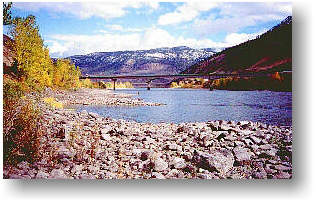
Turning
south at Ashcroft, the Thompson River makes its way through
the community of Spences
Bridge. During the summer months fishermen are
drawn to this spot by the arrival of Chinook salmon. However,
the Spences Bridge area is best known for its fabulous catch
and release steelheading.
Anglers
from all over British Columbia, Canada and the United States
converge on this tiny community (see
map of Spences Bridge area) during the months of
October, November and December. Legendary names such as Martel,
Rock Pile, Flat and Rock Run, Y Run, Grease Hole, Hotel Run,
Graveyard Run, Lake Pool, Orchard Run and Big Horn Pool are
forever etched in the minds of steelheaders who have already
visited this fabulous fishing area. For these fly, and gear
fishermen, the year would not be complete until they have made
their annual trip to the Thompson.
Many
of these fanatic anglers (most steelheaders are) will plan their
fishing trip into the B.C. interior by starting at the Dean
River in the summer months. During late summer/early fall, they
move on up to the North by Northwest region of B.C., where they
will fish the fabled waters of Sustut, Kispiox, Babine and Bulkley
rivers. Late fall through early winter they travel back down
to the Thompson, to finish up the year.
Thompson
River steelhead are legendary for two reasons. First, they are
big, often in the high teens with some in the 20+ lb. range
and the rare one that will reach 30 lbs. Second, they're incredibly
strong! When a Thompson fish decides to run, look out, it's
like trying to stop a runaway train. A possible reason for the
great strength may lie in the distance that they have to travel
(about 300 km./186 miles from Vancouver to Spences Bridge) and
the obstacles that they have to overcome, such as the Hells
Gate Canyon on the Fraser River.
New
fishermen to this river will be surprised to find that many
of these huge steelhead are colored. Not to worry. These steelhead
are summer-run fish in their prime. Unlike true winter-run steelhead,
these summer-runs will remain in the river for several months
before spawning. The Thompson fish will enter the freshwater
of the Fraser River in late August. The front runners start
showing up in the Spences Bridge area by mid-September. The
peak of the run occurs from mid-October to late November. These
steelhead will winter in the river, below Kamloops Lake, until
late May when they will start to move into tributaries along
the Thompson to begin spawning in June.
Getting
to the Thompson is easy, catching a trophy steelhead is not!
For one thing, there are not that many fish in the river. Runs
can number anywhere from 1000 to 4000 entering the river during
the season. Interception of steelhead stock in both the ocean
and the Fraser River have caused a decline in the number of
fish. However, the Fish and Wildlife branch of the Ministry
of Environment along with other organizations such as the Steelhead
Society of B.C. and the B.C. Federation of Flyfishers, are dedicated
to protecting and improving this great river. Special public
forums have been held, from which new ideas and regulations
have sprung. Before heading out to the river you should consult
the current B.C. Freshwater Fishing Regulations or contact the
Fish and Wildlife office at 1259 Dalhousie Drive, Kamloops,
B.C. V2G 5Z5, phone: (250) 371-6200.
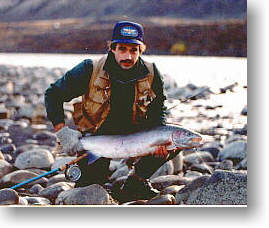
The
weather can also beat you. Fall and winter months can be very
cold and often windy. Also the Thompson River is big, fast and
strewn with large boulders, making it hard to cover and extremely
difficult to wade. It isn't uncommon for a novice steelheader
not to touch a steelie all season. Thompson veterans on the
other hand, have learned the secrets of this great river and
are usually successful throughout the fall and winter months.
Equipment
varies with the different techniques used on the river. General
rule of thumb - long rods and large capacity reels.
Gear
fishermen in general, fall into two categories. Bottom-bouncers
and float fishermen. Both employ drift fishing techniques and
basically the same type of rigging (terminal tackle). Bottom-bouncers
usually have large level wind reels coupled with 10 to 10-1/2
foot rods. Float fishermen have rods that are even longer and
are often accompanied with a centre-pin reel. Lures most commonly
used are: single egg imitations, gooey-bobs, super goobers,
spin 'n' glows, corkies, rubber worms (red, pink and orange),
or simply different colored wool (yarn) held onto the hook with
an egg loop. Spinners and spoons are seldom used but should
always be part of your arsenal.
Fly
fishermen can also be divided into 2 basic equipment groups.
Single-handed fly rods and double-handed (spey) rods. Single-handed
fly rods are usually 9-1/2 to 10 feet long. The most common
line weight is an 8 or 9. Spey rods are much longer. 15 and
16 foot rods are very common on the Thompson and most speyfishermen
say they have a great advantage over a 10 foot single-hand fly
rod. Reels on both types of rods have to be large to hold lots
of backing.
Fly
fishermen will usually start the season using a floating line
with a dry fly. The Thompson fish are famous for taking a surface
fly. Lemire's Fall Caddis or Grease
Liner work very well. Bomber patterns are also
very popular. Bill McMillan's Air
B.C. along with Ehor Boyanowsky's Thompson
River Rat have both gathered loyal followers.
As
the season progresses the weather gets colder, and the river
temperature starts to drop. The steelhead become less active
and tend not to move to the fly as aggressively as they did
earlier in the season. Fly fishermen will now switch to a sink-tip
line and wet fly. Art Lingren's Black
General Practitioner, Joe Kambeitz's Squamish
Poacher, and Pete Peterson's Pete's Lady Bug all
work extremely well. Spey flies and wet flies tied low-water
style are also extremely popular.
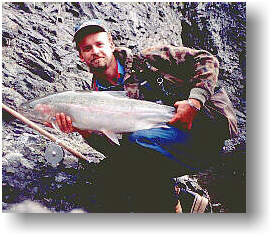
Many
people ask if there any flies which are considered the best
for the Thompson. The answer is no! Fishermen all have their
favorite patterns. The answer to fly selection is to use the
flies that you have the most confidence in and then stick to
those few flies!! Fly selection is considered by most steelheaders
the least in the order of importance. Weather, light and water
conditions will often vary from day to day. Be prepared and
have different size and colors of flies tied up. The art of
reading the river and knowing where steelhead are holding is
most important. Getting the fly to them is next. Presentation
is also important especially when using the floating live/dry
fly technique. In this case you trying to imitate a fluttering
surface fly such as a stonefly.
Hopefully this will trigger the juvenile feeding imprint in
the adult steelhead and it will take the fly.
Always
remember, the more the fly is in the water and not in the air
(keep false casts to a minimum), the better chance you'll have
touching steelhead. Also, whether you're a gear or a fly fisherman
it is vitally important to cover your drift thoroughly, your
trophy may be lying just a few feet from shore!
Spences
Bridge can be reached by traveling east and then north from
Vancouver on the Trans Canada Highway (Hwy.#1). The distance
is roughly 300 km./186 miles, with an approximate travel time
of just over 3 hours.
Services
(there are no fly and tackle shops!) and accommodations can
be found in Spences Bridge, as well as the nearby communities
of Ashcroft and Cache Creek. Private and public campgrounds
are available along both sides of the river. If planning a trip
to Spences Bridge during the peak steelhead season of late October
through mid-November it's best to call ahead and book reservations.
Continuing
on through Spences Bridge, the Thompson passes through Big Horn,
Gold Pan Provincial Park, Shaw Springs, and Skihist Provincial
Park before meeting the Fraser River at the town of Lytton (the
rafting capital of Canada).
This
river section is wild and fast, traveling through steep-sided
canyons and gorges. Access to the river from Shaw Springs to
Lytton is steep and dangerous. Fishing, whether for Chinook
or steelhead is very limited for this reason. However, white
water rafting and kayaking are extremely popular during the
summer and early fall.
The
Thompson is a river of spectacular beauty and is enjoyed by
thousands of recreationalists a year. Special care is required
by all to ensure a healthy future for this most special river.




 Flowing
from the Rocky Mountains, the North Thompson passes by the communities
of Blue Water, Avola, Vavenby, Clearwater, Little Fort, Barriere
and Heffley Creek before meeting the South Thompson at Kamloops.
Flowing
from the Rocky Mountains, the North Thompson passes by the communities
of Blue Water, Avola, Vavenby, Clearwater, Little Fort, Barriere
and Heffley Creek before meeting the South Thompson at Kamloops.

